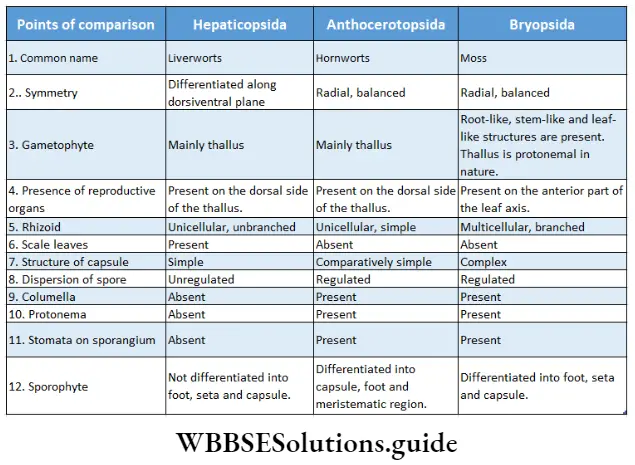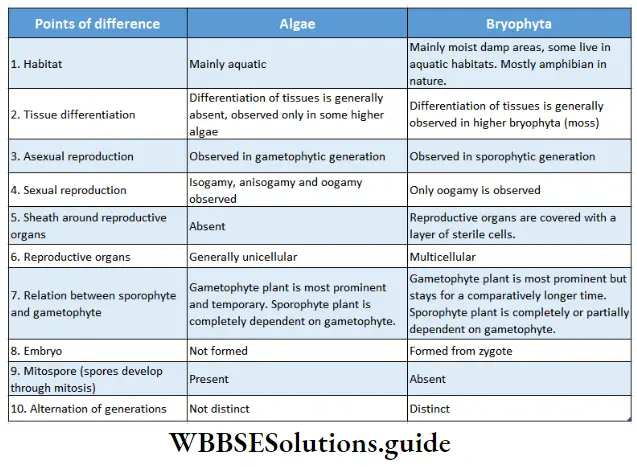Bryophyta
The term ‘bryophyta’ came from two Greek words bryon (moss) and phyton (plant).
Bryophyta Definition: Bryophytes are the simplest and most primitive, non-flowering, embryophytes, that do not contain vascular tissues.
Bryophyta Distribution: Bryophyta is the first group of plants to inhabit the land. They generally occur in moist and shady places. They are found at higher altitudes, on moist soil, stones, trunks and branches of trees. Though they are terrestrial, they require water to complete their life cycle, specifically during fertilisation. Therefore, they are considered as ‘the amphibians of plant kingdom’.
| Class 11 Biology | Class 11 Chemistry |
| Class 11 Chemistry | Class 11 Physics |
| Class 11 Biology MCQs | Class 11 Physics MCQs |
| Class 11 Biology | Class 11 Physics Notes |
Bryophyta Size and shape: The size of bryophytes may range from very small (1-3 mm) to large (60 cm). Generally, they grow within a height of 15 cm and are herbaceous in nature. They grow closely packed as mats or cushions on rocks, and soil, as epiphytes on the trunks and leaves or as free-floating in water. Most of the bryophytes show dichotomous branching. They are either thalloid or foliose.
Read and Learn More: WBCHSE Notes for Class 11 Biology
Bryophyta General features:
The important characteristics of bryophytes are as follows—
- The life cycle of bryophytes is divided into gametophytic and sporophytic phases (i.e., heteromorphic).
- The gametophytic phase is predominant and ecologically persistent, i.e., green, independent and long-lived.
- The sporophytic phase is very short-lived and completely dependent upon the gametophyte for nutrition and growth.
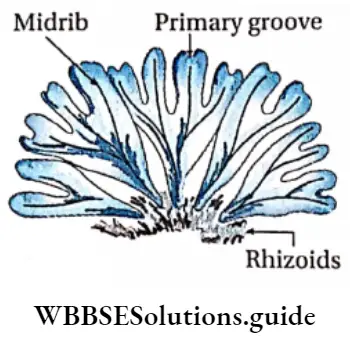
Characteristics of gametophytes: The characteristics of gametophytes have been discussed below.
Structure of gametophytes :
Gametophytes show the following structural features—
- The gametophytic plant body is either thalloid or differentiated into the root-like rhizoid, stem-like erect caulid and leaf-like phyllid.
- Roots are absent in bryophytes. Instead, structures called rhizoids, are present, and those perform the function of roots. They may be branched or unbranched, unicellular or multicellular. They are of two types smooth-walled (inner wall smooth) or tuberculated (inner wall with peg-like projections).
- The thread-like body structure, produced during the germination of spores to produce immature gametophytes is called protonema.
- The stem-like structure of bryophytes, above the ground is called caulid. These bear leaf-like structures are called phyllids.
- Multicellular, coloured scales, are present at the ventral side of the thallus. They protect the cells from friction with the substratum.
- Xylem and phloem are absent in these plants. They may have special lignin-containing, conducting tissue in sporophytes. Otherwise, the plant body is made up of parenchyma cells only.
- Air pores present in the thallus and stomata present in the capsule in moss, allow gaseous exchange with the environment.
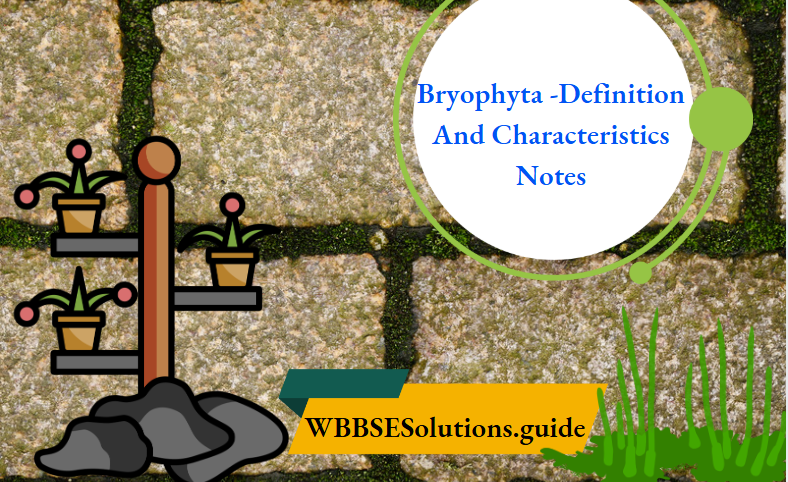
Bryophyta Reproduction: They reproduce by vegetative and sexual means. Asexual reproduction is completely absent in bryophytes.
- Vegetative propagation takes place by fragmentation or some special, structures, like gemmae, tubers, protonema, adventitious branches, persistent apices, etc.
- Sexual reproduction is of monogamous type. They have large, multicellular gametangia (sex organs), covered with a jacket of sterile cells.
- Bryophytes are unisexual, either homothallic (monoecious) or heterothallic (dioecious),
- The male sex organs, called antheridia, are multicellular, stalked, globose or ovoid structures. They have a single-layered thick jacket surrounding androgenic mother cells.
- Biflagellate sperms or antherozoids (male gametes) are produced from these cells,
- The female sex organs, called archegonia, are multicellular, vase-shaped or round-bottom flask-shaped structures,
- They have a swollen base, called a venter, containing a ventral canal cell and an egg, and the upper elongated neck containing neck canal cells.
- Both the venter and neck are surrounded by the single-layered jacket, made of sterile cells.
- The sperms are motile and swim through the water to reach the archegonia. Hence, water is required for sperm dispersal and subsequent fertilisation.
- The zygote does not pass through any resting phase. The diploid zygote or oospore develops into the embryo.
- Embryonic growth of the sporophyte begins within the venter of the archegonium, soon after fertilisation.
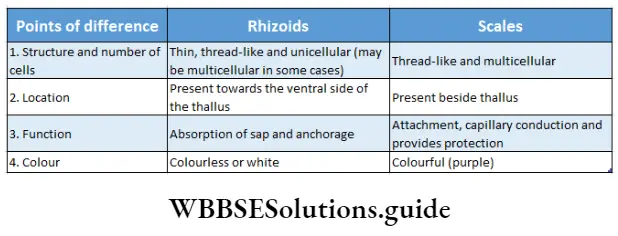
Exoscopic mode of development
The embryo follows an endoscopic mode of development. In this development, the zygote first divides transversely to form an outer epibasal cell and an inner hypobasal cell. The embryo develops from the epibasal cell. Thus, the shoot-forming apical cell is directed outwards, i.e., towards the neck of the archegonium.
Characteristics of Sporophytes:
- The sporophytes are diploid.they remain attached to the gametophytic plants for nutrition.
- They have bulbous feet, an unbranched stalk-like seta and a single terminal sporangium called a capsule. Sometimes the sporophyte is represented only by a capsule (Riccia sp.).
- The capsule has a protective covering called calyptra, which is a part of the gametophyte.
- Bryophytes are homosporous (spores are morphologically and physiologically identical). Spores are produced from the sporogenous cells of the capsule through meiotic division.
- The haploid (n) spore after germination either produces a filamentous germ tube that gives rise to a young gametophyte (for example Riccia spv Marchantia sp.) or produces a juvenile plant or protonema that ultimately gives rise to an adult gametophytic plant.
Bryophyta definition and characteristics notes PDF
Sporophytes Alternation of generations: The alternation of generations is of a heteromorphic nature. The main plant body is gametophytic and bears haploid germ cells. After fertilisation, a diploid zygote is produced.
This undergoes division and differentiation to form a diploid sporophytic (2n) plant. Haploid spores are produced within the spore mother cells of the sporangia in sporophytic plants by the process of meiosis.
These spores germinate to produce haploid gametophytic(n) generation. The alternation of generations In a typical bryophyte has been depicted In.
Some common examples of Bryophytes are—Riccia sp., Marchantia sp., Anthoceros sp., Pellia sp., Pogonatum sp., etc.
The commercial importance of Bryophyta: There are various commercial applications of bryophytes These have been discussed as follows—
Indicator Species: Both liverworts and mosses are often good indicators of environmental conditions. In Finland, terrestrial bryophytes are used to characterise forest types. Bryophytes are used as indicators for mineral concentration. Copper mosses grow almost exclusively in areas with high concentrations of copper, particularly copper sulphate. Thus they serve as good metal indicators.
Soil erosion control: Cultivation of bryophytes on bare land by spreading spores or vegetative fragments or propagules of bryophytes could help to prevent soil erosion. The protonemata, which develop from both fragments and spores, form mat-like structures that cover and bind exposed soil particles.
Class 11 biology Bryophyta notes with examples
Sphagnum sp. has a high water holding capacity. They control the water content of the soil during spring runoff in the Arctic. also responsible for soil formation and storing water It is during floods. They are used as nursery beds, for proper conservation of the plants.
Barometer
In Japan, H. Taoda (1976) developed a bryometer, a bag of mosses that respond in predictable ways to various levels of air pollution. By exposing a variety of mosses to various levels of SO2, he determined that most species are injured by 10-40 hours of exposure to 0.8 ppm SO2. Since that time, the use of the barometer has spread around the world.
Nitrogen fixation: Nitrogen is often a limiting nutrient for plant growth, especially in agriculture. Bryophyte crusts, endowed with nitrogen-fixing cyanobacteria, can contribute considerable nitrogen, particularly to dry soils.
Nostoc sp., a cyanobacterium living symbiotically with Anthoceros sp., is able to fix atmospheric nitrogen as an ammonium salt. Hence, it can be used as fertiliser.
pH regulation of soil: Sphagnum sp., helps to maintain the acidity of the soil. Hence, acid-loving plants or oxylophytes are known to grow in such soil.
Food sources: Bryophytes are very rarely consumed by the animals. They may be the source of specific needs of animals at a time when fresh food is scarce. These are used as food in snow-capped mountain regions.
Medicines: Bryophytes (especially liverworts) are used as herbal medicine. Numerous compounds, including oligosaccharides, polysaccharides, sugar alcohols, amino acids, fatty acids, and aliphatic compounds occur in bryophytes.
Short notes on Bryophyta for quick revision
Bryophytes such as Sphagnum sp. are used to treat skin diseases, and Marchantia polymorpha is used to treat liver ailments. Rhodobryum giganteum and R. roseum are used to treat cardiovascular diseases and nervous prostration.
Polytrichum commune reduces inflammation and fever. It is also used as a diuretic laxative and hemostatic agent. Haplocladium microphyllum is used to treat cystitis, bronchitis, etc.
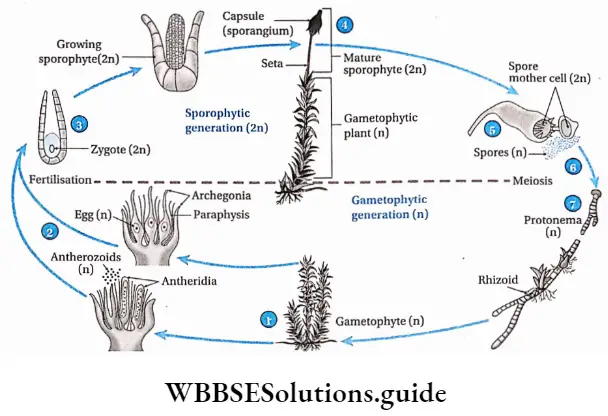
Classification of Bryophyta: Rothmaler (1951) classified bryophytes into three classes—Hepaticopsida, Anthoceropsida and Bryopsida. In accordance with the International Code of Botanical Nomenclature. Proskauer (1957) modified the classification of Rothmaler by changing the class name Anthoceropsida to Anthocerotopsida.

Class: Liverworts or Hepaticopsida
Liverworts General features:
- Gametophytes are dorsoventrally flattened, and thalloid in nature. Thallus dichotomously branched (apical growing point divided into two growing parts producing two branches in a forked manner). Each lobe of the thallus has a dorsal groove and an apical notch.
- The thallus structure has multicellular scales and unicellular rhizoids.
- The thallus has chloroplasts but is devoid of pyrenoids.
- Multicellular sex organs, i.e., antheridia and archegonia, are present on the dorsal side of the thallus. In some species (Marchantia sp.) sex organs are bore on specified structures called antheridiophores and archegoniophores.
- Male antheridia are stalked, globose or ovoid. Each antheridium has several antherozoid mother cells which produce biflagellate,comma-shaped antherozoids or sperms.
- Female archegonia is flask-shaped. Its lower part is called the venter and its upper slender part is called the neck. Inside the venter single egg is present.
- A sporophyte is devoid of foot and seta. Capsules are globose or ellipsoid, brown or black in colour. Setae are small delicate stalks. [Exception: Foot and seta are absent in the sporophyte of Marchantia sp.]
- The capsule wall is made up of a single-cell layer. The capsule contains haploid spores developed from spore mother cells through meiosis. Some species (for example Marchantia sp.) have haploid, needle-like elaters. These elaters help in the dehiscence of the capsule.
Some examples of Hepaticopsida are: Riccia sp., Marchantia sp.
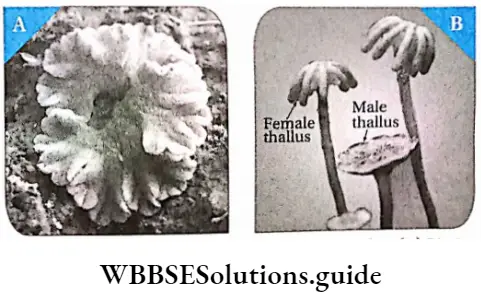
Class: Hornworts or Anthocerotopsida
Hornworts General features:
- Gametophytes are thalloid, with the structure being dorsoventrally flattened and irregularly lobed.
- The thallus is not differentiated into stems and leaves and is always homogeneous. Each cell has a chloroplast with centrally placed pyrenoids.
- Air cavities and scales may be absent, but smooth and septate rhizoids are present.
- The reproductive organs are present on the dorsal side of the thalamus.
- In some species, the thallus sometimes contains mucilage cavities which are inhabited by Nostoc, a cyanobacterium.
- The mature sporophyte shows a bulbous foot and a slender cylindrical capsule standing out like a bristle from the thallus. The meristematic zone is present at the basal part of the capsule. Seta is absent.
- Capsules have a central column of sterile cells called columella (Exception: In Notothylas, columella is absent). The spore mother cells remain surrounding the columella.
- The spore mother cells generate haploid spores through meiosis. The capsule also contains numerous unicellular structures resembling elaters, called pseudoelaters. Some examples of Anthocerotopsida are— Anthoceros sp., Notothylus sp., Ceratophyllum sp., etc.
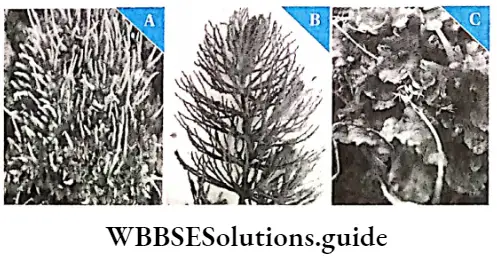
Class: Moss or Bryopsida
Moss or Bryopsida General features:
- Matured gametophytes, originating from branched protonema, are erect plants with a stem-like axis (caulid).
- The axis is covered with spirally arranged leaf-like phyllids.
- Phyllids are flattened leaf lamina-like structures, light green in colour with serrated margins. The midrib is prominent.
- Multicellular and branched rhizoids are present instead of roots. Caulids possess a cylinder of primitive conducting tissue, made up of thick-walled cells. A central, parenchymatous pith-like structure is also seen.
- Multicellular sex organs are present at the top of the branches of caulids. The sex organs develop at the axils of leafy structures called perichaetial leaves.
- Antheridia are small, stalked and dumbbell-shaped, while the archegonia are distinct and flask-shaped.
- Sporophyte is dependent on gametophytic plants. It is differentiated into foot, seta and capsule.
- The foot is bulbous and acts like a haustorium. Capsules may be green, brown, yellow or red in colour, with a short green, yellow or translucent seta.
- The capsule contains a dome-shaped spore sac containing sporogenous tissue, overarching a centrally located columella and single cell-layered thick ribbon-like trabeculae.
- At the top of the capsule, there is a cap-like structure called an operculum. Below the operculum one or more ring or teeth-like structures (peristome teeth) are present. These help in the opening of the capsule and the release of spores.
- The mature capsule is protected by a covering called calyptra. The diploid sporogenous tissues in the spore sac can produce haploid spores through meiosis. These spores germinate to form haploid protonema.
Some examples of Bryopsida are: Sphagnum sp., Funaria hygrometrica, Pogonatum sp., etc.
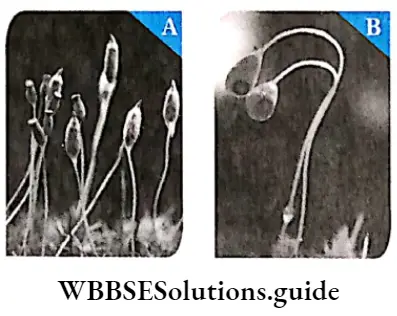
Bryophyta characteristics and classification with diagram
Similarities between algae and Bryophyta
- Both are non-flowering, autotrophic, without any vascular tissue.
- Both do not have roots. Generally, both of them have a thallus body structure.
- Both require water for their fertilisation. The male gametes are flagellate and hence, they are motile in nature.
- Both have cellulose in the cell wall.
- Protonema of mosses resembles the thread-like algae.
- Both have similar photosynthetic pigments.
- Gametophyte is the main plant body in both.
